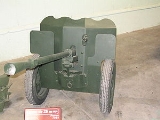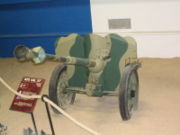
25 mm Hotchkiss anti-tank gun
Encyclopedia
The 25 mm Hotchkiss anti-tank gun was a French
anti-tank gun that saw service in the first years of the Second World War
.
had come to the realization that the armour-piercing capability of the 37 mm TRP infantry gun would be insufficient against modern tanks. In 1926 Hotchkiss
proposed a 25 mm in-house design that was eventually accepted for service in 1934, under the designation canon de 25 mm semi-automatique modèle 1934 (generally shortened to canon de 25) . At the outbreak of World War II, it was the main anti-tank weapon of the French infantry.
had insufficient numbers of anti-tank weapons such as the Ordnance QF 2 pounder
. They were issued canons de 25 which became known as Anti-Tank Gun, 25 mm. Hotchkiss, Mark I on 25 mm. Carriage, Mark I in British service.
Examples captured by the German forces were operationally used under the designation 2.5 cm Pak 112(f).
Finland purchased 50 French 25 mm M/37 antitank guns during Winter War
, but only 40 of them were delivered in February 1940 through Norway. The remaining ten guns were captured by the Germans when they invaded Norway in spring of 1940. About half of the guns, which had arrived during Winter War saw frontline service during it and three of them were lost in battle. During Interim Peace
the Germans sold 200 captured guns to Finland. 133 of them were model M/34 and 67 were model M/37, and they were designated 25 PstK/34 and 25 PstK/37, respectively. They were withdrawn from front-line use by 1943.
In 1935 the Hotchkiss 25 mm anti-tank gun was purchased for evaluation by the US Army
.

France
The French Republic , The French Republic , The French Republic , (commonly known as France , is a unitary semi-presidential republic in Western Europe with several overseas territories and islands located on other continents and in the Indian, Pacific, and Atlantic oceans. Metropolitan France...
anti-tank gun that saw service in the first years of the Second World War
World War II
World War II, or the Second World War , was a global conflict lasting from 1939 to 1945, involving most of the world's nations—including all of the great powers—eventually forming two opposing military alliances: the Allies and the Axis...
.
Development
By the early 1920s the French ArmyFrench Army
The French Army, officially the Armée de Terre , is the land-based and largest component of the French Armed Forces.As of 2010, the army employs 123,100 regulars, 18,350 part-time reservists and 7,700 Legionnaires. All soldiers are professionals, following the suspension of conscription, voted in...
had come to the realization that the armour-piercing capability of the 37 mm TRP infantry gun would be insufficient against modern tanks. In 1926 Hotchkiss
Hotchkiss et Cie
Société Anonyme des Anciens Etablissements Hotchkiss et Cie was a French arms and car company established by United States engineer Benjamin B. Hotchkiss, who was born in Watertown, Connecticut. He moved to France and set up a factory, first at Viviez near Rodez in 1867, then at Saint-Denis near...
proposed a 25 mm in-house design that was eventually accepted for service in 1934, under the designation canon de 25 mm semi-automatique modèle 1934 (generally shortened to canon de 25) . At the outbreak of World War II, it was the main anti-tank weapon of the French infantry.
Foreign use
When it landed in France in 1939 the British Expeditionary ForceBritish Expeditionary Force (World War II)
The British Expeditionary Force was the British force in Europe from 1939–1940 during the Second World War. Commanded by General Lord Gort, the BEF constituted one-tenth of the defending Allied force....
had insufficient numbers of anti-tank weapons such as the Ordnance QF 2 pounder
Ordnance QF 2 pounder
The Ordnance QF 2-pounder was a British anti-tank and vehicle-mounted gun, employed in the Second World War. It was actively used in the Battle of France, and during the North Africa campaign...
. They were issued canons de 25 which became known as Anti-Tank Gun, 25 mm. Hotchkiss, Mark I on 25 mm. Carriage, Mark I in British service.
Examples captured by the German forces were operationally used under the designation 2.5 cm Pak 112(f).
Finland purchased 50 French 25 mm M/37 antitank guns during Winter War
Winter War
The Winter War was a military conflict between the Soviet Union and Finland. It began with a Soviet offensive on 30 November 1939 – three months after the start of World War II and the Soviet invasion of Poland – and ended on 13 March 1940 with the Moscow Peace Treaty...
, but only 40 of them were delivered in February 1940 through Norway. The remaining ten guns were captured by the Germans when they invaded Norway in spring of 1940. About half of the guns, which had arrived during Winter War saw frontline service during it and three of them were lost in battle. During Interim Peace
Interim Peace
The Interim Peace was a short period in the history of Finland during the Second World War. The term is used for the time between the Winter War and the Continuation War, lasting a little over a year, from 13 March 1940 to 24 June 1941...
the Germans sold 200 captured guns to Finland. 133 of them were model M/34 and 67 were model M/37, and they were designated 25 PstK/34 and 25 PstK/37, respectively. They were withdrawn from front-line use by 1943.
In 1935 the Hotchkiss 25 mm anti-tank gun was purchased for evaluation by the US Army
United States Army
The United States Army is the main branch of the United States Armed Forces responsible for land-based military operations. It is the largest and oldest established branch of the U.S. military, and is one of seven U.S. uniformed services...
.
Variants

- 25 SA 35 - a shortened variant used in tanks and armoured cars such as the Panhard 178Panhard 178The Panhard 178 or "Pan-Pan" was an advanced French reconnaissance 4x4 armoured car that was designed for the French Cavalry before World War II...
. - 25 SA 37 - a derivative designed by the APX with a much lighter carriage.

